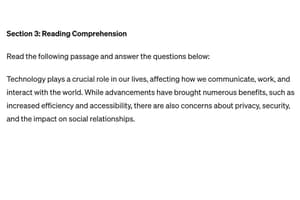Podcast
Questions and Answers
Which of the following sentences demonstrates correct subject-verb agreement?
Which of the following sentences demonstrates correct subject-verb agreement?
- The cat and dog is playing together.
- The group of students is studying for their tests. (correct)
- The team are winning the game.
- She go to the store every Saturday.
A complex sentence contains only one independent clause.
A complex sentence contains only one independent clause.
False (B)
What is the main idea of a passage?
What is the main idea of a passage?
The central point or concept that the author wants to convey.
The _____ dog barked loudly at the mailman.
The _____ dog barked loudly at the mailman.
Match the vocabulary terms with their definitions:
Match the vocabulary terms with their definitions:
Which of the following is an example of a misplaced modifier?
Which of the following is an example of a misplaced modifier?
Context clues can help determine the meanings of unfamiliar words.
Context clues can help determine the meanings of unfamiliar words.
What are the three main tenses in English?
What are the three main tenses in English?
An author writes to _____, entertain, or inform the audience.
An author writes to _____, entertain, or inform the audience.
Which of the following best describes the author's purpose in writing a news article?
Which of the following best describes the author's purpose in writing a news article?
Flashcards
What are nouns?
What are nouns?
Words that name persons, places, things, or ideas.
What are pronouns?
What are pronouns?
Words that replace nouns in a sentence.
What are verbs?
What are verbs?
Words that describe actions or states of being.
What are adjectives?
What are adjectives?
Signup and view all the flashcards
What are adverbs?
What are adverbs?
Signup and view all the flashcards
What is a simple sentence?
What is a simple sentence?
Signup and view all the flashcards
What is a compound sentence?
What is a compound sentence?
Signup and view all the flashcards
What is a complex sentence?
What is a complex sentence?
Signup and view all the flashcards
What is the main idea?
What is the main idea?
Signup and view all the flashcards
What is inference?
What is inference?
Signup and view all the flashcards
Study Notes
English Diagnostic Test for Grade 5
Grammar Assessment
- Parts of Speech: Identify and use nouns, pronouns, verbs, adjectives, and adverbs correctly in sentences.
- Sentence Structure: Recognize simple, compound, and complex sentences; practice writing and identifying these structures.
- Punctuation: Correct use of periods, commas, question marks, and quotation marks in sentences.
- Subject-Verb Agreement: Ensure subjects and verbs agree in number (singular/plural).
- Tenses: Understand and use past, present, and future tenses accurately in writing and speaking.
- Modifiers: Identify and correctly place adjectives and adverbs to avoid misplaced modifiers.
Reading Comprehension
- Main Idea: Determine the main idea of a passage and support it with details from the text.
- Inference: Make inferences based on context clues to understand implicit meanings.
- Summarization: Summarize paragraphs or entire texts, focusing on key points and themes.
- Character Analysis: Identify and describe characters' traits, motivations, and relationships in stories.
- Text Features: Utilize headings, captions, diagrams, and charts to enhance understanding of informational texts.
- Author’s Purpose: Analyze why an author wrote a text (to inform, entertain, persuade) and how this affects tone and style.
Vocabulary Skills
- Context Clues: Use surrounding words and sentences to infer meanings of unfamiliar words.
- Synonyms and Antonyms: Identify and generate synonyms and antonyms for targeted vocabulary words.
- Word Roots and Affixes: Understand basic prefixes, suffixes, and roots to decipher word meanings.
- Homophones and Homographs: Distinguish between words that sound alike but have different meanings, and those that are spelled alike.
- Vocabulary in Context: Use vocabulary words in sentences to demonstrate understanding and proper usage.
- Word Maps: Create visual representations of words, including definitions, synonyms, antonyms, and usage in sentences.
Grammar Assessment
- Identify and use parts of speech: nouns, pronouns, verbs, adjectives, adverbs.
- Recognize and write sentence structures: simple, compound, and complex sentences.
- Correctly use punctuation marks: periods, commas, question marks, quotation marks.
- Ensure subject-verb agreement in terms of singular and plural forms.
- Understand and apply verb tenses: past, present, and future during writing and speaking.
- Use modifiers (adjectives and adverbs) accurately to avoid misplaced modifiers.
Reading Comprehension
- Determine the main idea of a passage and substantiate it with supporting details.
- Make inferences using context clues for deeper understanding of text.
- Summarize texts by focusing on essential points and overarching themes.
- Analyze characters in stories by identifying their traits, motivations, and relationships.
- Utilize text features such as headings, captions, diagrams, and charts for better comprehension.
- Analyze author's purpose for writing texts, which can include informing, entertaining, or persuading, and its effect on tone and style.
Vocabulary Skills
- Infer meanings of unfamiliar words using context clues from the surrounding text.
- Identify and generate synonyms (similar meanings) and antonyms (opposite meanings) for vocabulary words.
- Understand word components: prefixes, suffixes, and roots to deduce meanings.
- Distinguish between homophones (same sound, different meanings) and homographs (same spelling, different meanings).
- Demonstrate understanding of vocabulary by using words appropriately in sentences.
- Create word maps that visually represent words, including definitions, synonyms, antonyms, and examples.
Studying That Suits You
Use AI to generate personalized quizzes and flashcards to suit your learning preferences.




